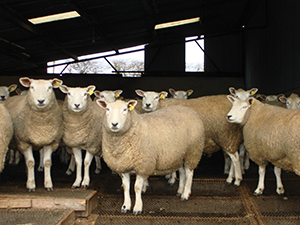Farm productivity “must improve” in Ireland
Alan Renwick, Professor of Agriculture and Food Economics at University College Dublin, outlines why there needs to be changes in farm productivity in Ireland.
A snapshot of Irish agriculture’s business performance at the end of March this year would have reflected an industry that was in pretty good shape, according to Alan Renwick, Professor of Agriculture and Food Economics at UCD.
“Milk had just enjoyed a 12 month period of pretty buoyant returns, particularly during those peak output months of 2014. Beef prices were on the up and the euro had weakened, thereby making Irish food exports that much cheaper in markets such as the UK,” he says.
“In fact, the fundamental market drivers at that time would have indicated that the growth targets included within the Harvest 2020 strategy might be easily obtained. And, of course, we have subsequently had the publication of the Food Wise 2025 report.”
Renwick confirms that milk output in Ireland has increased by 12 per cent during April, May and June this year, compared with the same period in 2014.
“This is a direct result of milk quotas ending. And, up to a point, this is good news. But in so many other ways, Irish agriculture is not changing.
“For example, 40 per cent of our beef farmers are totally reliant on their Single Payment to make ends meet. They cannot survive on the back of what the marketplace is delivering for them. And, from a purely economic perspective, this is a far from satisfactory scenario.”
The long-term
Renwick also points out that ever-increasing market prices cannot be relied upon to deliver long term sustainability for Irish agriculture.
“Recent reversals in world milk prices confirm that markets can fall as well as rise,” he says.
“This is a fundamental trading reality, so the real driver for Irish agriculture moving forward must be that of securing improved farm productivity. But the worrying fact is that we are falling behind all of our major competitors in this regard.”
The UCD economist indicates that the farming industries of China, Brazil and New Zealand are achieving annual productivity increases of between 3 per cent and 4 per cent.
“Here in Ireland the equivalent figure is around 2 per cent. And that’s not really good enough,” he explains.
Renwick readily admits that the part-time nature of farming in Ireland, particularly where beef and sheep are concerned, plus the extremely fragmented physical structure of Irish agriculture represent key productivity improvement barriers. He poses the question: “Can the market and EU policy really support 100,000 cattle farmers in this country?”
“I recognise the social benefits of keeping as many people as possible on the land. And, no doubt this will remain a key plank of future government policy. But the fact remains that we need to see the more efficient farmers in Ireland securing additional growth if the productivity challenge is to be tackled successfully.”
But it’s all from bad news in this regard. Renwick welcomes the opportunities under the new CAP arrangements that will facilitate the development of farm partnerships.
“This measure has tremendous potential. In the first instance it will allow younger people within farm families to have a say in the running of the business that much earlier,” he says.
“But it will also allow the issue of land mobility to be tackled in that more general sense. There is a fundamental recognition within Irish agriculture that more can be done to encourage older farmers to work with their younger counterparts in a share farming type of arrangement.
“And I heartily encourage developments of this nature. This is a model that is already working successfully in countries like New Zealand.
“We have the land base that is required to drive future productivity: the challenge is that of utilising this resource more efficiently.”
Market volatility
Renwick buys into the principle that the long term prospects for agri-food in Ireland remain bright, but quickly points to market volatility as being an important challenge for both farmers and processers to cope with over the coming years.
“The fundamental facts have been well profiled: the world’s population is set to increase by 50 per cent over the next three decades and the projected growth in the economies of China and the rest of South East Asia will ensure that the money is available to buy all of the extra food that is required,” he says.
“But I am concerned about the recent downturn in the Chinese stock market. No one is sure if this is a short, sharp shock effect or if more long term factors are coming into play regarding the future stability of China’s economy.
“If the latter is the case, then it may have an impact on Chinese consumer trends, particularly where imported dairy and other high value food products are concerned. My own view is that the key economic drivers for China remain fundamentally sound.”
Renwick also holds the view that the current strategy of the dairy processing sector to produce high quality ingredients for international infant milk formula manufacturers, such as Wyeth, represents a viable way forward for the industry.
“We need to develop more of these opportunities. The only potential weakness in the system is that of finding ways to shelter milk producers from the direct impact of market volatility.
“Farmers are weak buyers and weak sellers. Moreover, they have no one to pass the pain of a market crash on to. The buck really does stop with them.”
Given these circumstances, the UCD economist believes that Ireland’s dairy co-ops and other milk processers should actively seek to establish long term supply contract arrangements with their farmer suppliers.
“These agreements should be based on an agreed price structure, at least for a proportion of the farmers’ milk,” he says.
“This would then give individual producers a degree of much needed stability and confidence moving forward.”
He also points out that technology has a key role to play in enhancing the competitiveness of the Irish dairy sector.
“It can also act as a risk management strategy. But a framework is needed that enables new technologies to be robustly evaluated in terms of their ability to allow dairy farms to deal with uncertainty, thereby enhancing the resilience of the milk industry.
“It is important that the development and adoption of new technologies is undertaken in such a way that it increases rather than undermines the resilience of the dairy sector.”
Renwick confirms the risks confronting milk producers fall into the following categories: human and personal; production; price and market; institutional and financial. However, factors such as the abolition of quotas will change the relative importance of these risks.
“We also need to take account of emerging risks,” he says. “These include on farm risk-management strategies and strategies to share risks with others.
“Technology adoption may therefore be seen both as a source of risk to businesses, but also as a risk management strategy. Technologies need therefore to be evaluated not just in terms of how they increase average performance and profitability, but also how they perform in a climate of uncertainty as a risk reduction strategy.”







